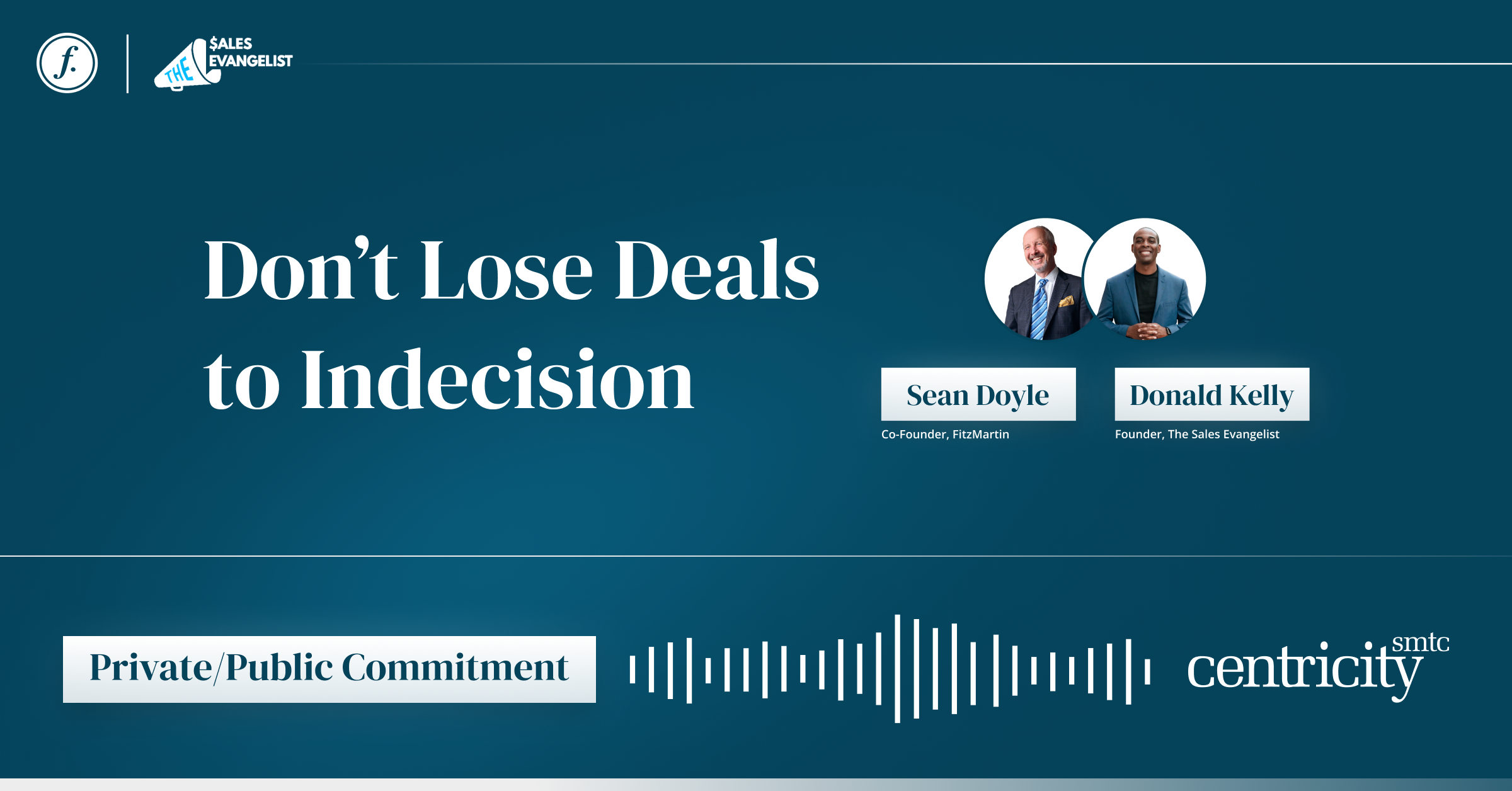Commitment: Don’t Lose Deals to Indecision

One of the most exciting parts of the sales journey—besides the actual closing of the deal, of course—happens mid-funnel when the prospect has moved from contemplating the product or service to actually preparing to make the purchase. It’s clear the prospect is intending to take action, and the deal feels this close to completion, even though there is still something clearly missing: a commitment. If the salesperson isn’t careful, visions of dollar signs take over, and their focus on the buyer’s needs go right out the window (along with the sale). Why? Because the buyer has yet to make a private commitment. Until a prospect makes a private commitment, the customer journey is far from over. This part of the process requires the salesperson to slow down instead of aggressively pushing forward in the deal. If the salesperson proceeds slowly, while keeping their efforts centered around the buyer’s needs as they go through the process of change, the end result can be obtaining the private commitment needed to get the deal done.
Why Are Private and Public Commitments Important?
Before a deal of any kind can be finalized, a decision (or commitment) first has to be made. That means the buyer has to make a commitment to challenge the status quo before they can ever take the action (public commitment) to do so. Once a prospect is to the point when a private commitment is possible, they are beyond looking at the past and seeking out third-party information; they are instead looking forward and preparing to take action. A salesperson should notice this shift in the prospect and at this point can introduce techniques to the sales process to help the prospect move toward the next step.
Fight Off Indecision
During this preparation stage before making a commitment, two buyer behaviors typically enter the scene: The prospect is re-evaluating themselves and their problem. Too often at this stage, salespeople can be too focused on their product or service—why they think their solution is so great and how it’s going to fix the buyer’s problem—that they do not have a plan in place to help the prospect thoroughly consider why the same plan they’ve had in place over the last few years isn’t producing results. This can often lead to indecision—prospects getting to a certain point of the sales journey but getting stuck and never moving forward. Frankly, many companies lose out on potential sales because of this indecision. A recent study from HBR revealed that out of 2.5 million recorded sales calls, between 40% to 60% of the deals were lost to people who expressed an intent to commit but failed to actually act.
Maintaining a Buyer Focus
To avoid losing the deal to indecision, salespeople must keep the prospect moving forward. They do that by continuing to focus on the needs of the buyer, which change at each step of the journey. At this point in the process, it requires helping the prospect further consider the pros and cons of making the change instead of continuing to push all the bells and whistles of their product or services. How can you assure the prospect that it’s in their best interest to make the commitment? It may be giving them an opportunity to try out the product or service and see how it works for them. There are many examples of companies that do this well, such as Warby Parker, the eyeglass company that allows buyers to order and try multiple pairs before committing to a purchase. Or Amazon’s Prime Try Before You Buy, which allows buyers to select garments to have shipped to them to try on before ever purchasing. The examples could go on and on–yet in this scenario, a key point to remember is that salespeople must be careful to not push the prospect into closing too early. It must be done in the buyer’s timeframe. Pushing signals to the buyer that you’re really just concerned about your goals, not theirs. The point is to help the prospect evaluate how they are going to be personally served.
An under-used technique salespeople should consider is asking the prospect how they think the product or service would benefit them. It’s easy to feel that asking a question like this is being too intrusive, but it can be a powerful way to solidify in the buyer’s mind what matters most to them and lead the prospect to commit to what they know would help (i.e., your product or service).
Another powerful technique to help the prospect evaluate how your offering will serve them and lead to a private commitment is providing a concise business case. Send the prospect a concise, well-thought-out email illustrating how their needs could be solved (avoid focusing on your product or service). This not only illustrates that you’re keeping their interest top of mind, but it also equips the buyer with something that can be taken to decision makers and used to prove why your product or service is the clear choice when they are ready to take their private commitment public.
Sales & Marketing: A Dynamic Duo
It can be quite tempting to avoid doing any of this “extra” work to get the prospect to cross the line into commitment—especially without knowing if the effort will result in getting the desired deal. But it is very much possible, if sales and marketing teams are aligned throughout the process. When sales and marketing teams work together, companies see a 36% higher customer retention rate and a 38% higher win rate. This is certainly work worth pursuing.
Our podcast is dedicated to helping small and mid-market businesses thrive and develop the sales and marketing acumen to move the needle. Tune into our episode featuring sales expert and founder of The Sales Evangelist, Donald Kelly, to learn more about consultative selling and guided help to finalize more sales for your company.